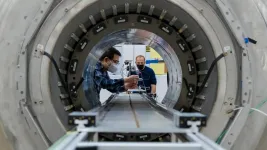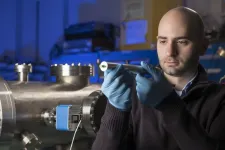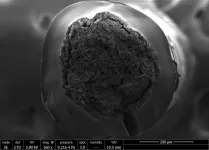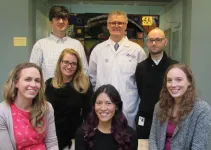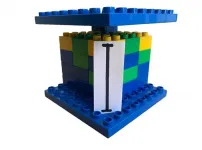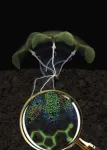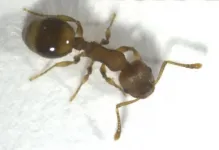What do touch screens, radiation therapy and shrink wrap have in common? They were all made possible by particle physics research. Discoveries of how the universe works at the smallest scale often lead to huge advances in technology we use every day.
Scientists from the U.S. Department of Energy's (DOE) Argonne National Laboratory and Fermi National Accelerator Laboratory, along with collaborators from 46 other institutions and seven countries, are conducting an experiment to put our current understanding of the universe to the test. The first result points to the existence of undiscovered particles or forces. This new physics could help explain long-standing scientific mysteries, and the new insight adds to a storehouse of information that scientists can tap into when modeling our universe and developing new technologies.
"These findings could have major implications for future particle physics experiments and could lead to a stronger grasp on how the universe works." -- Ran Hong, Argonne postdoctoral appointee
The experiment, Muon g-2 (pronounced Muon g minus 2), follows one that began in the '90s at DOE's Brookhaven National Laboratory, in which scientists measured a magnetic property of a fundamental particle called the muon.
The Brookhaven experiment yielded a result that differed from the value predicted by the Standard Model, scientists' best description of the makeup and behavior of the universe yet. The new experiment is a recreation of Brookhaven's, built to challenge or affirm the discrepancy with higher precision.
The Standard Model very precisely predicts the muon's g-factor -- a value that tells scientists how this particle behaves in a magnetic field. This g-factor is known to be close to the value two, and the experiments measure their deviation from two, hence the name Muon g-2.
The experiment at Brookhaven indicated that g-2 differed from the theoretical prediction by a few parts per million. This miniscule difference hinted at the existence of unknown interactions between the muon and the magnetic field -- interactions that could involve new particles or forces.
The first result from the new experiment strongly agrees with Brookhaven's, strengthening the evidence that there is new physics to discover. The combined results from Fermilab and Brookhaven show a difference from the Standard Model at a significance of 4.2 sigma (or standard deviations), slightly less than the 5 sigma that scientists require to claim a discovery, but still compelling evidence of new physics. The chance that the results are a statistical fluctuation is about 1 in 40,000.
Particles beyond the Standard Model could help to explain puzzling phenomena in physics, such as the nature of dark matter, a mysterious and pervasive substance that physicists know exists but have yet to detect.
"This is an incredibly exciting result," said Argonne's Ran Hong, a postdoctoral appointee who worked on the Muon g-2 experiment for over four years. "These findings could have major implications for future particle physics experiments and could lead to a stronger grasp on how the universe works."
The Argonne team of scientists contributed significantly to the success of the experiment. The original team, assembled and led by physicist Peter Winter, included Argonne's Hong and Simon Corrodi, as well as Suvarna Ramachandran and Joe Grange, who have since left Argonne.
"This team has an impressive and unique skill set with high expertise regarding hardware, operational planning and data analysis," said Winter, who leads the Muon g-2 contributions from Argonne. "They made vital contributions to the experiment, and we could not have obtained these results without their work."
To derive the muon's true g-2, the scientists at Fermilab produce beams of muons that travel in a circle through a large, hollow ring in the presence of a strong magnetic field. This field keeps the muons in the ring and causes the direction of a muon's spin to rotate. The rotation, which scientists call precession, is similar to the rotation of earth's axis, only much, much faster.
To calculate g-2 to the desired precision, the scientists need to measure two values with very high certainty. One is the rate of the muon's spin precession as it traverses the ring. The other is the strength of the magnetic field surrounding the muon, which influences its precession. That's where Argonne comes in.
Field trip Although the muons travel through an impressively constant magnetic field, ambient temperature changes and effects from the experiment's hardware cause slight variations throughout the ring. Even these small shifts in field strength, if not accounted for, can significantly impact the accuracy of the g-2 calculation.
In order to correct for the field variations, the scientists constantly measure the drifting field using hundreds of probes mounted to the walls of the ring. In addition, they send a trolley around the ring every three days to measure the field strength where the muon beam actually passes through. Mounted on the trolley are probes that map out the magnetic field with incredibly high precision throughout the ring's 45-meter circumference.
To reach the ultimate uncertainty goal of less than 70 parts per billion (around 2.5 times better than the field measurement in the previous experiment), Argonne scientists refurbished the trolley system used in the Brookhaven experiment with advanced communication abilities and new, ultraprecise magnetic field probes developed by the University of Washington.
The trolley goes around the ring in both directions, taking around 9,000 measurements per probe and direction. The scientists use the measurements to reconstruct slices of the magnetic field and then derive a full, 3D map of the field in the ring. Field values at points on the map go into the g-2 calculation for muons passing through those locations. The better the field measurements, the more meaningful the final result.
The scientists also converted some of the analog signals used in the old experiment into digital signals to increase the amount of data they could obtain from the probes. This required complex engineering of the trolley's communications system to minimize disturbances to the sensitive probing mechanisms.
"It was quite challenging to make the trolley operate smoothly and safely. It required the control system to handle routine operations but also identify emergencies and react appropriately," said Hong, whose background in both scientific research and engineering was crucial for designing the trolley to operate with limited disruption to the experiment.
The team plans to upgrade the trolley system for the next data taking period to further improve the measurements by reducing the uncertainty bit by bit.
Fine tuning In precision experiments like Muon g-2, the main objective is to reduce any systematic uncertainty or error that could affect the measurements.
"Measuring the raw numbers is relatively easy -- figuring out how well we know the numbers is the real challenge," said Corrodi, a postdoctoral appointee in Argonne's High Energy Physics division (HEP).
To ensure the accuracy of the magnetic field measurements, the scientists calibrated the probes using Argonne's 4-Tesla Solenoid Facility, which houses a magnet from a former magnetic resonance imaging (MRI) scanner. The magnet produces a uniform and stable magnetic field with over 400 times the strength of a refrigerator magnet.
Argonne scientists calibrated the probes in the trolley against readings from a probe that was designed and tested inside the solenoid magnet. This process ensures the probes each read the same measurement when in the same magnetic field and enables the scientists to make accurate corrections. The test facility allowed the scientists to achieve field measurements down to several parts per billion -- like measuring the volume of water in a swimming pool down to the drop.
"In addition to calibrating the probes, we improved the field measurements by adjusting operation settings on the fly," said Corrodi, "During data analysis, we found some effects we did not expect."
When Corrodi and team saw glitches in the data, they investigated the system to pinpoint the cause. For example, certain devices in the ring focus the muon beam to keep it centered. These devices, however, slightly disrupt the magnetic field in the ring. The scientists designed a way to measure this effect in order to remove it from the analysis.
To view related video, click here.
Putting it all together The journey of the magnetic field data from probe to computer is complex. Corrodi, Hong and others configured the hardware and software to read the data from the field probes with the correct time and location stamps. They also had to make sense of the data, which start out in binary code, in order to integrate them with the common analysis framework for the experiment.
"We had to convert the raw data into something we could work with," said Hong, "and we were in charge of the data quality control, determining what flawed data to discard in the ultimate g-2 analysis."
Corrodi will lead the analysis team for the magnetic field, resolving conflicts with equipment and making sure the various teams in the experiment converge on the next result, said Winter. "You really need to understand the entire field analysis in order to reach our scientific goals."
The future of muon experiments The first thing the scientists plan to do is to double-check the results.
"So far, the precision of the ultimate g-2 measurement is comparable to that of the Brookhaven experiment, but that is dominated by the fact that the data are limited so far," said Corrodi. "We have only analyzed 6% of the data we plan to take over the entire experiment. Those added data will reduce the uncertainty significantly."
The first result is also encouraging to scientists conducting other present and planned muon experiments, including a future g-2 experiment that will be conducted in Japan, and the next muon experiment at Fermilab -- the Mu2e experiment. These projects are already using Argonne's Solenoid Facility to cross-calibrate their magnetic field probes with the ones used at Fermilab.
"There could be a renewed effort to look for muons at the Large Hadron Collider, searching for possible hints of the new physics behind the g-2 value," said Carlos Wagner, a theoretical physicist in Argonne's HEP, who works to try to explain these phenomena. "There could also be renewed interest in the construction of a muon collider, which could provide a direct way of checking this new physics."
Once scientists get a handle on this new physics, it may be able to inform cosmological and quantum mechanical models, or even help scientists to invent new technologies down the road -- the next shrink wrap, perhaps.
INFORMATION:
The collaboration published a paper on the result in Physical Review Letters, titled "Measurement of the positive muon anomalous magnetic moment to 0.46 ppm." A paper on the magnetic field measurement was also published in Physical Review A, titled "Magnetic-field measurement and analysis for the Muon g - 2 Experiment at Fermilab."
The work on Muon g-2 at Argonne is funded by DOE's Office of Science, High Energy Physics.
About Argonne's Center for Nanoscale MaterialsThe Center for Nanoscale Materials is one of the five DOE Nanoscale Science Research Centers, premier national user facilities for interdisciplinary research at the nanoscale supported by the DOE Office of Science. Together the NSRCs comprise a suite of complementary facilities that provide researchers with state-of-the-art capabilities to fabricate, process, characterize and model nanoscale materials, and constitute the largest infrastructure investment of the National Nanotechnology Initiative. The NSRCs are located at DOE's Argonne, Brookhaven, Lawrence Berkeley, Oak Ridge, Sandia and Los Alamos National Laboratories. For more information about the DOE NSRCs, please visit https://science.osti.gov/User-Facilities/User-Facilities-at-a-Glance.
Argonne National Laboratory seeks solutions to pressing national problems in science and technology. The nation's first national laboratory, Argonne conducts leading-edge basic and applied scientific research in virtually every scientific discipline. Argonne researchers work closely with researchers from hundreds of companies, universities, and federal, state and municipal agencies to help them solve their specific problems, advance America's scientific leadership and prepare the nation for a better future. With employees from more than 60 nations, Argonne is managed by UChicago Argonne, LLC for the U.S. Department of Energy's Office of Science.
The U.S. Department of Energy's Office of Science is the single largest supporter of basic research in the physical sciences in the United States and is working to address some of the most pressing challenges of our time. For more information, visit https://energy.gov/science.
